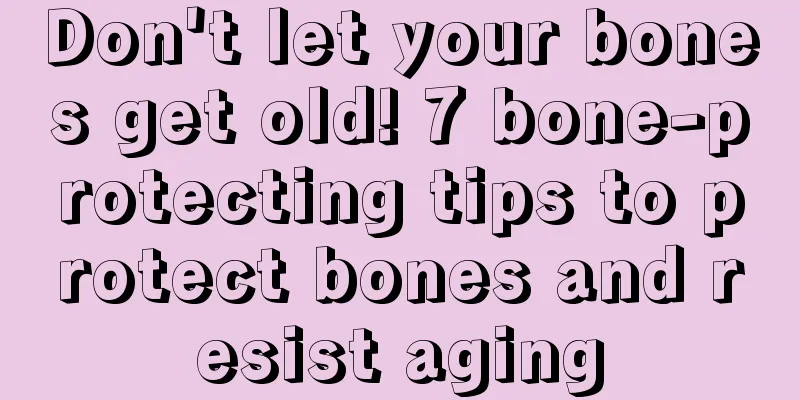Don't let your bones get old! 7 bone-protecting tips to protect bones and resist aging

|
Did you know that after you turn 28, your body's bone calcium will decrease at a rate of 0.1%-0.5% each year? The loss of bone calcium will not only lead to diseases such as pre-mirror syndrome and osteoporosis, but also cause minor symptoms such as hunchback, back pain and cramps. Therefore, if you want to maintain bone health, you must do a good job of bone protection now! Anti-aging is a lifelong issue for many women. When we look at ourselves in the mirror and feel complacent about our beautiful appearance, we ignore the aging of our internal body. If you have cramps every time you get up in the morning, always have back pain, have a habitual hunchback, or become shorter, be careful! You may be at high risk of osteoporosis! Women are a high-risk group for osteoporosis, especially after the age of 28, when bone calcium decreases at a rate of 0.1% to 0.5% per year. Therefore, experts remind us to live a life that preserves and protects our bones while we are young, so that even when we are older we can still maintain strong bones and walk briskly. Want to “protect your bones and fight aging”? Just follow the following 4 tips, pay attention to diet and exercise, and you can prevent the invasion of osteoporosis and live a carefree life until old age! Tip 1 for bone preservation: Get enough calcium Bones are the body's largest calcium storage depot, containing approximately 99% of calcium, with only 1% retained in the blood and circulating throughout the body. When there is not enough calcium in the blood, the bones will automatically release calcium to support and make up for the deficiency in the blood. If this continues, it may cause osteoporosis! Experts recommend that people can increase their calcium intake by drinking 1.5 to 2 cups of 240 ml low-fat dairy products or their products every day. If you don’t like the taste of milk or are lactose intolerant, it is recommended that you consume high-calcium foods such as cheese, black sesame seeds, dried fish, traditional tofu, and dark green vegetables. Since calcium is a relatively heat-resistant nutrient, you can also add milk to dishes to get enough calcium. Bone-preserving secret 2: Reduce sugar in your diet to protect the collagen in your bones Bones are mainly composed of "calcium" and "collagen". When calcium is attached to the network structure formed by collagen, it can maintain the structure and form strong bones. In other words, even if you try your best to supplement calcium, if you don't take care of the collagen in your bones, you will still be at risk of fractures. So, how do we maintain the collagen in our bones? Experts offer a simple tip: don't let your blood sugar rise, so that excess sugar in your body won't attach to the protein, causing collagen to lose its original elasticity and softness, making the bones brittle and the bone quality to begin to deteriorate. It’s actually very simple to prevent glycation from happening. For example, you must control your sweets intake, otherwise you will age faster than your peers. Or you can eat vegetables first when eating to prevent your blood sugar level from rising sharply. Bone preservation secret 3: Make sunbathing a part of your life In addition to calcium and collagen, Shirasawa Takuji believes that vitamin D is also very important. The reason is that vitamin D can help calcium absorption. If there is a lack of vitamin D, drinking more milk will be in vain. Fortunately, our skin can produce vitamin D after being exposed to ultraviolet rays, and it is amazingly efficient! Experts recommend that going outdoors for at least 30 minutes of sunbathing at least once a week can help prevent osteoporosis. For those who stay indoors all the time, please take a step-by-step approach and gradually increase the sunshine time so that the body can slowly adapt. Bone-preserving secret 4: fast walking and climbing stairs can strengthen bones Exercise creates pressure on bones, causing nanoscale ultra-micro damage inside the bones, which in turn activates osteoblasts to repair injured tissues. If you lie down all day without exercising, your osteoblasts will not be stimulated and your bone density will be low. In order to stimulate bone formation, it is best to choose exercises that allow the bones to bear body weight directly. For example, "brisk walking" and "climbing stairs" are both good choices. It is best to achieve an exercise intensity that makes you feel "a little breathless and a little strenuous." Some experts suggest that if a speed close to running is taken as 100%, then walking at about 70% of the speed is best, which is about 130 to 150 steps per minute. Once you stop exercising, you start losing bone mass. Therefore, even if you are a busy person, please make use of the trivial time in your life to continue exercising and maintain your bone quality and bone density! Bone-preserving secret 5: Accelerate calcium absorption Some nutrients are good partners with calcium and can help calcium be absorbed and utilized in the body. These nutrients include vitamin D, magnesium, vitamin C, etc. Vitamin C: The large amount of vitamin C in fruits such as navel oranges, grapefruits, tangerines, tangerines, and lemons can make calcium better absorbed by the small intestine. Magnesium: Calcium and magnesium are like twin brothers. They always appear in pairs. When the ratio of calcium to magnesium is 2:1, it is most conducive to the absorption and utilization of calcium. Therefore, while supplementing calcium, pay attention to magnesium intake. Foods rich in magnesium include: nuts (almonds, cashews and peanuts), seeds (sunflower seeds, pumpkin seeds), grains (millet and barley), seafood (tuna, shrimp, lobster), etc. Vitamin D: Vitamin D is the most important factor affecting calcium absorption. Vitamin D in food and 7-dehydrocholesterol in human skin are synthesized into vitamin D3 after exposure to sunlight, and then hydroxylated in the liver, especially the kidneys, to produce 1,25-dihydroxyvitamin D, which can promote the absorption of calcium in the small intestine and even in the colon. If the human body lacks 1,25-dihydroxyvitamin D, the absorption of calcium is only 10%. If vitamin D is supplemented and 1,25-dihydroxyvitamin D is synthesized in the liver and kidneys, the calcium absorption rate will increase to 60-75%. Bone preservation tips 6: Learn to reduce stress and beware of drug risks After the age of 35, the peak period of bone reserves ends, while women aged 30 to 39 are in the development period of their careers and are under great pressure. Many women will also complete the task of childbearing during this stage. Therefore, special attention should be paid to the following points: 1. Learn to reduce stress. Because stress hormones such as cortisol inhibit bone growth and accelerate bone loss. Moreover, due to high stress, it is easy to cause nutritional deficiencies, leading to secondary osteoporosis. 2. Beware of drug risks. Because of the increased stress, the immune response will be obvious and the chance of using drugs will increase. Corticosteroids used to treat asthma, inflammatory bowel disease and other diseases can interfere with calcium absorption, thereby damaging bone health. Bone protection secret 7: Pay attention to menstrual abnormalities and protect the ovaries Irregular menstruation means that bone density begins to decrease. Moreover, unlike men, whose bone density decreases relatively slowly, women's bone density decreases mostly suddenly, and calcium loss is accelerated due to the action of osteoclasts. Therefore, women in menopause should try to delay ovarian aging, try not to undergo hysterectomy, and eat less hormone-containing foods such as fast-growing chicken. |
<<: 7 signs that prove you are healthy
Recommend
What is the cause of perianal itching and moisture
Perianal itching and dampness is a common disease...
What is the cause of laryngeal cancer?
The exact cause of laryngeal cancer is still uncl...
What do you experience from massaging your ears every day for a year?
In daily life, if there is no discomfort in the e...
What are the symptoms of bone cancer? Pay attention to these three symptoms
Bone cancer can have a great impact on a person&#...
The clinical manifestations of female ovarian cancer include various cachexia
The clinical manifestations of ovarian cancer oft...
Can you still eat moldy brown sugar?
If brown sugar is moldy, many people will be very...
What are the causes of swelling in both lower limbs
The legs are the part that supports the entire bo...
What causes pain around the umbilicus in children?
When children are sick, parents are the ones who ...
Why does my left chest hurt when I breathe?
For friends who feel pain in the left chest when ...
What are the symptoms of chronic pharyngitis? It turns out there are these three types
Chronic pharyngitis is a common disease in daily ...
Which Chinese medicine hospital is good for prostate cancer
Many prostate cancer patients are recommended by ...
Learn how traditional Chinese medicine treats bone cancer?
In recent years, bone cancer has become one of th...
What are the symptoms of gastric metastasis of rectal cancer
Cancer is considered a terrible disease, but what...
What causes red, itchy and swollen eyes? Be careful of these eye diseases
Everyone must be very concerned about the phenome...
Chemotherapy for esophageal cancer must be performed at the correct stage of the disease
The rapid development of medical technology has m...









